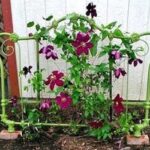Small vegetable garden designs and layouts have become increasingly popular among urban and suburban dwellers who want to enjoy the benefits of growing their own fresh produce. From maximizing space to promoting sustainability, small vegetable gardens offer a range of advantages that make them an attractive option for many people.
In this article, we will explore the trend of small vegetable gardens and why they have captured the interest of gardening enthusiasts. We will delve into the various benefits of cultivating a small vegetable garden, from environmental sustainability to health and wellness. Additionally, we will provide practical tips and ideas for planning, designing, and maintaining a successful small vegetable garden.
As more individuals seek to embrace a sustainable and self-sufficient lifestyle, the appeal of growing one’s own food in a small space has never been greater. With considerations such as limited outdoor areas or time constraints, small vegetable gardens offer viable solutions for those looking to connect with nature and foster a sense of accomplishment through gardening.
Join us as we explore the world of small vegetable garden designs and layouts, and discover how you can cultivate your own little green oasis.
The Benefits of Small Vegetable Gardens
Small vegetable gardens offer a wide range of benefits that make them an attractive option for both novice and experienced gardeners. Here are some of the key advantages to consider when planning your small vegetable garden:
- Efficient Use of Space: Small vegetable gardens allow you to make the most of limited outdoor areas such as balconies, patios, or small yards. By carefully planning and maximizing the available space, you can cultivate a variety of crops without the need for expansive land.
- Fresh, Organic Produce: With a small vegetable garden, you have the opportunity to grow your own organic fruits and vegetables right at home. This not only ensures access to fresh produce but also allows you to control what goes into the growing process, avoiding harmful chemicals and pesticides.
- Cost Savings: Growing your own vegetables can lead to significant savings on grocery bills over time. By producing your own food, you can reduce reliance on store-bought items and enjoy a sustainable source of healthy, affordable nutrition.
Furthermore, small vegetable gardens provide an excellent opportunity for hands-on learning and a deeper connection with nature. Whether it’s teaching children about where their food comes from or simply getting in touch with the earth, these gardens offer numerous educational and therapeutic benefits.
In addition to these advantages, small vegetable gardens contribute positively to environmental sustainability by promoting local food production, reducing transportation emissions, and minimizing reliance on industrialized agricultural practices. With careful planning and maintenance, these compact gardens can play an important role in fostering more self-sufficient and eco-friendly communities.
Planning Your Small Vegetable Garden
When planning your small vegetable garden, there are several important factors to consider to ensure its success. Whether you have limited space or simply prefer a smaller scale garden, thoughtful planning is key to maximizing your harvest. Here are some key factors to consider when planning your small vegetable garden:
Factors to Consider:
1. Sunlight: Determine the amount of sunlight your garden will receive on a daily basis. Most vegetables need at least 6 hours of direct sunlight, so choose a location that can provide this.
2. Space: Assess the available space for your garden and consider how much room each vegetable will need to grow. Some plants may require more space than others, so plan accordingly.
3. Soil Quality: Test the soil in your chosen location to ensure it is suitable for growing vegetables. Consider investing in raised beds or containers if your soil quality is poor or if you have limited space.
4. Water Access: Ensure that your garden area has easy access to water for irrigation. Proper watering is crucial for the success of your vegetables, so choose a location that allows for convenient watering.
5. Climate: Consider the climate of your region and select vegetables that are well-suited for the conditions in which you live. Some plants thrive in cooler weather, while others prefer warmer temperatures.
By carefully considering these factors, you can plan and design a small vegetable garden that will yield a bountiful harvest despite its limited size. Taking the time to assess these considerations will ultimately set you up for success in cultivating a thriving small vegetable garden.
Selecting the Right Vegetables for Your Small Garden
When planning a small vegetable garden, it’s essential to be selective about the vegetables you choose to grow. Limited space means that you’ll need to prioritize the veggies that will thrive in your specific growing conditions and that are well-suited to your culinary preferences. Here are some important factors to consider when selecting the right vegetables for your small garden:
Climate and Growing Conditions
The first thing to consider when selecting vegetables for your small garden is your climate and growing conditions. Different vegetables have different temperature and sunlight requirements, so it’s crucial to choose varieties that are well-suited to your specific location. For example, if you live in a cooler climate, you may want to consider cold-hardy vegetables like kale, spinach, and carrots, while those in warmer climates might opt for tomatoes, peppers, and eggplant.
Space Requirements
Since space is limited in a small vegetable garden, it’s important to choose vegetables that won’t take up too much room. Look for compact or dwarf varieties of popular veggies like cucumbers, squash, and beans. Additionally, consider vertical gardening techniques for vining plants like peas or pole beans to maximize space.
Culinary Preferences
Ultimately, the best vegetables for your small garden are the ones that you and your family enjoy eating. Consider what types of veggies you use most often in your cooking and prioritize those when making your selections. Additionally, think about which varieties of each vegetable you prefer – whether it’s heirloom tomatoes or sweet bell peppers – so you can truly enjoy the fruits of your labor in your small vegetable garden.
By carefully considering these factors when selecting vegetables for your small garden, you can ensure a bountiful harvest of delicious produce that is well-suited to both your growing conditions and culinary preferences.
Small Vegetable Garden Design Ideas
When it comes to designing a small vegetable garden, maximizing space is essential. With limited area, it’s important to make the most of every inch of land in order to grow a variety of produce. One popular design idea for maximizing space in a small vegetable garden is using vertical gardening techniques. This involves growing plants upwards on trellises, fences, or walls, allowing for more crops to be grown in a smaller footprint.
Another great design idea for small vegetable gardens is interplanting, which involves growing different types of vegetables together in the same area. By combining plants that have different root depths or growth habits, you can make efficient use of the available space and maximize your yield. For example, interplanting shallow-rooted lettuce with deep-rooted tomatoes can help you get the most out of your small garden.
Lastly, companion planting is an effective way to maximize space and increase productivity in a small vegetable garden. Certain plants benefit from being grown next to each other, either by deterring pests or improving growth. By strategically arranging your vegetables based on their compatibility with one another, you can create a harmonious and productive garden that makes the most of its limited space.
| Design Idea | Description |
|---|---|
| Vertical Gardening | Growing plants upwards on trellises, fences, or walls. |
| Interplanting | Growing different types of vegetables together in the same area. |
| Companion Planting | Strategically arranging vegetables based on their compatibility with one another. |
Layout Options for Small Vegetable Gardens
When it comes to designing a small vegetable garden, the layout is key to maximizing space and ensuring successful growth. There are several layout options that are particularly well-suited for small gardens, including raised beds, containers, and vertical gardening.
Raised Beds
One popular layout option for small vegetable gardens is raised beds. These are essentially boxes or frames filled with soil that are elevated off the ground. Raised beds offer several advantages for small gardens, including better soil drainage, improved access for planting and weeding, and the ability to maximize space by planting in square foot patterns. Additionally, raised beds have the potential to extend the growing season as the soil in them warms up faster in the spring.
Containers
For those with very limited outdoor space or even just a balcony or patio area, container gardening is an excellent choice. Small vegetables like lettuce, herbs, tomatoes, and peppers can thrive in containers. By using pots and hanging baskets strategically placed around your outdoor living area, you can benefit from fresh produce without needing a traditional garden plot.
Vertical Gardening
Vertical gardening is another effective layout option for small vegetable gardens. By utilizing trellises, fences, walls, or specially designed vertical planters, you can grow a variety of vine crops like cucumbers, squash, and peas without taking up valuable ground space. Vertical gardening not only maximizes space but also creates an attractive visual feature in your garden.
By considering these layout options for your small vegetable garden design and selecting the right one based on your available space and personal preferences, you can create a productive and beautiful garden even within limited square footage.
Tips for Maintaining and Nurturing a Small Vegetable Garden
When it comes to maintaining and nurturing a small vegetable garden, there are several tips and tricks that can help ensure a successful harvest. One important factor to consider is the watering schedule.
Small vegetable gardens may need more frequent watering due to their limited soil volume, so it’s essential to monitor the moisture levels regularly and water as needed. Using a drip irrigation system or soaker hoses can also help ensure that your plants receive consistent and adequate water without wastage.
In addition to watering, proper spacing of plants is crucial for the health and productivity of a small vegetable garden. Overcrowding can lead to competition for nutrients and sunlight, as well as increased susceptibility to pests and diseases. Be sure to follow the recommended spacing guidelines for each type of vegetable you’re growing, and consider using trellises or vertical gardening techniques to maximize space while promoting air circulation.
Furthermore, regular maintenance tasks such as weeding, pruning, and fertilizing are essential for keeping a small vegetable garden healthy. Weeds can quickly take over in a small space, so staying on top of them is crucial. Pruning helps promote proper growth and prevents overcrowding, while fertilizing provides essential nutrients for robust plant development. By incorporating these maintenance tips into your gardening routine, you can set your small vegetable garden up for success.
| Maintenance Tips | Details |
|---|---|
| Watering Schedule | Monitor moisture levels regularly; consider drip irrigation or soaker hoses |
| Proper Spacing | Follow recommended spacing guidelines; utilize trellises or vertical gardening techniques |
| Regular Maintenance Tasks | Weeding, pruning, fertilizing are crucial for plant health |
Case Studies
In this section, we will explore real-life examples of successful small vegetable gardens and the strategies that led to their success. These case studies will provide practical insights and inspiration for those looking to start their own small vegetable garden.
One example is Emily’s urban balcony garden. Despite living in a small apartment with limited outdoor space, Emily was able to transform her balcony into a productive vegetable garden. She utilized vertical gardening techniques by hanging planter boxes on the balcony railing, maximizing the use of available space.
Additionally, she carefully selected compact and dwarf varieties of vegetables that were well-suited for container gardening. Through proper planning and attention to detail, Emily’s balcony garden provided her with a bountiful harvest throughout the growing season.
Another case study is David’s raised bed garden. With a small backyard, David opted for raised beds to make the most of his limited space. He carefully planned the layout of his garden beds to ensure efficient use of space while allowing easy access for tending to the plants.
By using quality soil and practicing crop rotation, David was able to maintain healthy soil conditions and prevent pest and disease issues. His strategic approach resulted in a flourishing vegetable garden that supplied his family with fresh produce all year round.
Lastly, we have Sarah’s container garden on her apartment rooftop. Facing similar challenges as many city dwellers, Sarah creatively designed an urban oasis filled with an array of vegetables in containers. By incorporating trellises and vertical supports, she effectively utilized vertical space and grew vine crops such as tomatoes and cucumbers. Sarah’s dedication to regular watering and fertilizing led to a vibrant container garden that showcased the potential for small-space vegetable gardening in urban environments.
These case studies demonstrate that successful small vegetable gardens are achievable with careful planning, innovative design, and commitment to nurturing the plants throughout the growing season. By learning from these real-life examples, aspiring gardeners can gain valuable insights into creating their own thriving small vegetable gardens regardless of their limited space constraints.
Conclusion
In conclusion, the future of small vegetable garden designs and layouts looks promising as more people are embracing the idea of growing their own food in limited spaces. With the increasing interest in sustainability and self-sufficiency, small vegetable gardens offer an accessible way for individuals and families to participate in gardening and enjoy the benefits of fresh produce.
As urban areas continue to expand, small vegetable gardens will become even more essential for those living in apartments or homes with limited outdoor space. The trend towards sustainable living also suggests that small vegetable gardens will remain popular for years to come, providing a source of fresh, organic produce right at home.
As technology and innovation continue to advance, we can expect to see even more creative designs and layouts for small vegetable gardens. From vertical gardens to compact, efficient raised beds, there are endless possibilities for maximizing space and productivity. The future of small vegetable garden designs and layouts is bright, offering a rewarding and sustainable way to connect with nature and enjoy the fruits of our labor.
Frequently Asked Questions
How Do You Layout a Small Vegetable Garden?
To layout a small vegetable garden, it’s important to consider the space you have and the sunlight exposure in that area. You’ll want to plan out where each type of vegetable will go, making sure they’re spaced appropriately for their size and growth habits.
Consider using raised beds or containers to maximize space and make maintenance easier. Also, be sure to include pathways for easy access and maintenance.
How Do You Organize a Small Vegetable Garden?
Organizing a small vegetable garden involves keeping track of what you’ve planted where, staying on top of watering and weeding, and ensuring proper spacing between plants to avoid overcrowding. It’s also helpful to group together vegetables with similar water and sunlight needs for more efficient care.
Using trellises or cages for vining plants can also help keep things tidy in a small space.
What Vegetables Should Not Be Planted Together?
Some vegetables should not be planted together due to their incompatible growth habits or potential for disease transmission. For example, planting potatoes and tomatoes together can spread diseases like blight.
Additionally, certain vegetables may compete for nutrients when planted near each other, such as cucumbers and potatoes. Researching companion planting and crop rotation techniques can help you avoid planting incompatible vegetables together in your garden.

Welcome to my gardening blog! I am passionate about plants and enjoy sharing my knowledge and experiences with others. In this blog, I will write about everything related to gardening, from tips on how to get started to updates on my own garden projects.





